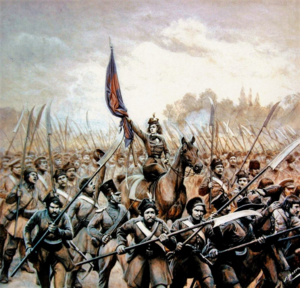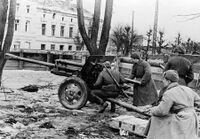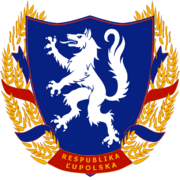History of Luepola: Difference between revisions
No edit summary |
|||
| Line 48: | Line 48: | ||
==Kingdom of Luepola (1390-1818)== | ==Kingdom of Luepola (1390-1818)== | ||
[[File:Bitwa_pod_Wiedniem_Brandt.jpg|thumb|200px|left|The Battle of Obránse during the East Patyrian War.]] | [[File:Bitwa_pod_Wiedniem_Brandt.jpg|thumb|200px|left|The Battle of Obránse during the East Patyrian War.]] | ||
Two years after the surrender of Zacotia, in 1390, Luka declared that the Kingdom of Varadna-Strentland would be renamed to the Kingdom of Luepola, after the name of the tribal ancestors of the Kingdom of Strentland, the Luppoli. Over the following centuries, Luepola would fight a number of conflicts with ever-shifting alliances, in order to expand primarily southward and westward. These wars saw the annexation of [[Aneska]], significant portions of [[Granzery]] and [[Lairea]], and small portions of [[Vorochia]], [[Vyzinia]], and the Vierz kingdoms. | Two years after the surrender of Zacotia, in 1390, Luka declared that the Kingdom of Varadna-Strentland would be renamed to the Kingdom of Luepola, after the name of the tribal ancestors of the Kingdom of Strentland, the Luppoli. Over the following centuries, Luepola would fight a number of conflicts with ever-shifting alliances, in order to expand primarily southward and westward. These wars saw the annexation of [[Kingdom of Aneska|Aneska]], significant portions of [[Granzery]] and [[Lairea]], and small portions of [[Vorochia]], [[Vyzinia]], and the Vierz kingdoms. | ||
As an Orthodox country, it often politically and sometimes military wrestled with [[Cestros]] for the status of the premiere Orthodox nation of Patyria. However, certain religious conflicts would unite the countries in alliance, most notably in the [[East Patyrian War]], which pitted the Orthodox world against the Catholic world over the harboring of Protestant refugees in Luepola, Cestros, and [[Yugaria]]. | As an Orthodox country, it often politically and sometimes military wrestled with [[Cestros]] for the status of the premiere Orthodox nation of Patyria. However, certain religious conflicts would unite the countries in alliance, most notably in the [[East Patyrian War]], which pitted the Orthodox world against the Catholic world over the harboring of Protestant refugees in Luepola, Cestros, and [[Yugaria]]. | ||
With the majority of Luepola's coastline on the [[Oriental Sea]], the Kingdom of Luepola sought for much of its history to attain hegemony over the sea. The same advances in shipbuilding which made possible the exploration and colonization of the New World were used to modernize the Luepolan Navy and deploy it to west [[Oridia]] and north [[Tusola]], to establish and capture trading posts, ports, and ultimately land. | With the majority of Luepola's coastline on the [[Oriental Sea]], the Kingdom of Luepola sought for much of its history to attain hegemony over the sea. The same advances in shipbuilding which made possible the exploration and colonization of the New World were used to modernize the Luepolan Navy and deploy it to west [[Oridia]] and north [[Tusola]], to establish and capture trading posts, ports, and ultimately land. | ||
==First Luepolan Republic (1818-1901)== | ==First Luepolan Republic (1818-1901)== | ||
Revision as of 01:46, 18 September 2020
This article is incomplete because it is pending further input from participants, or it is a work-in-progress by one author. Please comment on this article's talk page to share your input, comments and questions. Note: To contribute to this article, you may need to seek help from the author(s) of this page. |

The history of Luepola begins with the westward migration of the early Molves from their homeland in Aneska or Vorochia in the fifth century. Motivated partly by the concurrent Grozyar Migration, the Molves found themselves variously entering servitude under, or waging war against, the Veisic tribes of northern and eastern Patyria, as well as the stagnating Deoran Empire. Medivold, chieftain of the Berzi, is credited with uniting the southern Molvic tribes into a tribal confederation and, together with the Veisic TBD and Grozyar TBD, beginning the invasions that would lead to the Sack of Deora and the final collapse of the Deoran Empire under Megenfrit.
Following the fall of Deora, the Molvic tribal confederation collapsed to infighting, with more prominent tribes eventually coalescing into nation-states. The most prominent of these was the Zacotii, a large south Molvic tribe which expanded rapidly in the 9th century, eventually forming the Zacotian Empire, and forcing the assimilation of some tribes and migration of others. Two of the tribes that migrated, the Varadii and Bosonii, migrated to the northern reaches of the East Patyrian plain; the Bosonii settled in the vicinity of Utrna and the Varadii near Zvin. These two tribes grew into the kingdoms of Strentland and Varadna, respectively.
In 1329, the Kingdom of Varadna-Strentland was founded by Genadi the Great, a Strentlandish king who had entered personal union with the future Queen of Varadna; over the course of the century, the lands of Varadna-Strentland came to be known as Luepola. Over the following centuries, Luepola would fight a number of conflicts with ever-shifting alliances, in order to expand primarily southward and westward. These wars saw the annexation of the small Kingdom of Aneska and the annexation of territory from Luepola's surrounding neighbors, including Granzery and member kingdoms of the Vierz League.
The Kingdom of Luepola ended with a revolution in 1818, in the midst of the Caberran Wars. Gordăn Petrušić, the leader of the newly-declared First Republic of Luepola, initially allied himself with Antonio de Caberra in the second phase of the war against the Vierz Empire, but later allied with Vierzland to defeat Tierada in the third phase of the war. Petrušić subsequently established the first nationwide democratic elections in Luepola in 1829. In the aftermath of the Caberran Wars, Luepola moved to secure ports and territory in west Oridia. Luepola would later play a minor role in the Patyrian conquest and colonization of Tusola.
As Flecquism rose to prominence in Patyria, Luepola increasingly fell sway to Flecquist movements and rhetoric, particularly after the Patyrian Revolutions and the independence of Vonzumier from the Vierz Empire. By the turn of the 20th century, the Communist party under Lev Gincburg took control of the country and transformed it into a one-party state, known as the People's Republic of Luepola. Luepola became the de facto leader of the Communist world, aiding Communists throughout the world, most notably in Apelia and Poicary.
Continued belligerence under Luepola's subsequent leaders and recent allies led to the Great War, the deadliest conflict in human history, which saw the defeat of the Socialist International Coalition at the hands of the allied powers. Luepola's head of state Anton Marusić was killed, the communist government dissolved, and the country was occupied by Vierzland.
Reorganized as the State of Luepola, the country was a key state of the Vierz bloc for the majority of the Silent War, as Vierzland's closest and most tightly-controlled satellite state. However, ordinary citizens of both sides severely resented the other, and Vierz subjugation of the Luepolan populace led to the March Uprising, a series of mass protests and riots that resulted in the Sliet sanctioning a military coup of the Luepolan government, prompting a Vierz invasion of the country. The Luepolan War saw the rise of Emil Ivanušić as a national figurehead, whose moral leadership and military prowess proved critical to salvaging the nearly-destroyed Luepolan war effort and ultimately securing a favorable peace for Luepola in the Treaty of Skalla.
Since the end of the war, Luepola has stablized and regrown its economy, and has pursued an independent foreign policy, relying equally on trade and relations from Vonzumier and its allies, and the Aitic Federation, though public opinion largely favors the latter over the former. Luepola has stirred controversy in the recent past by providing assistance to the Sahwanists in the Great Bakran War and by electing Zeki Sorelki, the first West Oridian head of state of a Patyrian country, and the first openly socialist head of state to rule Luepola since the Great War.
Prehistory
Early History
Westward Migration of the Molves
Tribal Confederation under Medivold
Padivold and the destruction of Deora
Collapse of the Tribal Confederation
Varadna-Strentland (1329-1390)
Establishment of Varadna-Strentland
The Kingdom of Luepola, then known as Strentland-Varadna, was established in 1329 by Genadi the Great. At the time, Genadi was the king of Strentland, and was married to Princess Vladislava I of the neighboring Kingdom of Varadna. In 1429, Queen Anna of Varadna died a sudden death. As the Varadian line of succession followed a system of Absolute primogeniture, the throne was passed to Vladislava. The coronation of Genadi's wife as the Queen of Varadna left Genadi the Younger, their firstborn son, as the heir to both thrones. Recognizing this development, Genadi and Vladislava began work consolidating their two kingdoms, in preparation for the merge, with the nobility of each kingdom encouraged to marry into the other. On August 4, 1329, Genadi and Vladislava jointly declared the establishment of Varadna-Strentland.
The War of Luepolan Succession
Genadi's death in 1355 saw the passing of the throne to his son, Genadi the Younger. His rule aimed to complete the unification of Varadna-Strentland, consolidating the houses of Modrić and Kitarović into a single house. His efforts, however, were largely unsuccessful. After attempting to pressure nobles into marrying into eachother's houses, Genadi the Younger was assassinated in 1363. Genadi the Younger's death started a succession crisis - as the houses of Modrić and Kitarović had not yet unified, they each followed different orders of succession, leading to disagreement as to who should succeed Genadi the Younger on the throne. The House of Kitarović, from which Vladislava I hailed, followed a system of absolute primogeniture, and believed that Genadi's sister, Princess Cvieta, should inherit the throne. The House of Modrić, on the other hand, followed male-preference primogeniture, and believed that Genadi's brother, Prince Nikolas, should succeed him, despite him being younger than Cvieta.
This disagreement quickly erupted into a full-blown civil conflict, with the nobles of the House of Modrić and the House of Kitarović, and their servants and supporters, battling one another. This has since become known as the War of Luepolan Succession. Though the House of Modrić initially had the upper hand in the war due to its support base spanning the former territory of the larger Kingdom of Strentland, the relatively progressive ideals of the House of Kitarović appealed to the broader populace of Varadna-Strentland, enabling Princess Cvieta's support base to expand, an advantage that transformed itself into numerous victories. In the Battle of Širotsk in 1368, Cvieta's army killed Nikolas and inflicted massive casualties on his army, forcing the pro-Modrić army to surrender. The peace agreement acknowledged Cvieta as the rightful heir the throne of Varadna-Strentland, and shortly after the cessation of hostilities she was coronated as Cvieta I.
During the war, Cvieta married Paveu Brnić, the highest ranking officer of the pro-Kitarović army who was not a member of the house, and in 1366 gave birth to Prince Luka, who would become the next king of Varadna-Strentland.
In an act of reconciliation to her former foes, she issued the Edict of Mlaževo in 1369, which exchanged amnesty to the nobles of the House of Modrić who were put on trial in return for the House of Modrić agreeing to adopt a system of absolute primogeniture. Having forced the House of Modrić to adopt an order of succession that legitimized herself as dynast, Cvieta declined to reinstate herself into the house of Kitarović, which left the Modrić dynasty as the official ruling dynasty of Varadna-Strentland.
Containment Wars
Shortly after the end of the War of Luepolan Succession, Varadna-Strentland faced war from its neighbors Plosenia and Zacotia, whose leaders both feared the potential powerhouse in the east that the new union could become, and who sought to take advantage of Varadna-Strentland's weakened post-war state to strike it down and gain land and influence. In 1374, the Zacotian army marched into Strentland and laid siege to the port of Rostva, beginning the Containment War. The Containment War quickly bogged down into a stalemate on both fronts.
Cvieta I died of natural causes in 1382, leaving 16-year-old Luka as the wartime monarch of Varadna-Strentland. Luka's first edict as the new King of Varadna-Strentland temporarily restored his powers as commander of the army to his father, Paveu Brnić, who previously had been delegated the same powers under Cvieta. Mistaking the transition of power as a potential period of confusion and disorder in Varadna-Strentland, Zacotia and Plosenia both launched large-scale offensives against Varadna-Strentland, which were quickly routed by the unexpectedly strong and organized defense.
Luka's next significant action was to appeal to the neighboring Kingdom of Vyzinia. With the aid of older, more experienced diplomats, Luka successfully encouraged Joseph IV of Vyzinia to declare war on Plosenia in 1386, promising them much of Plosenia's land and the wealth within. The deployment of the Vyzinian army to Plosenia threw Plosenia into disarray, enabling the army of Varadna-Strentland to push into Plosenia. The northern front culminated in the Siege of Pomorna in 1387, which forced the surrender of Plosenia to Vyzinia and Varadna-Strentland. Recognizing the soon-to-be dire situation for their army, Zacotia surrendered to Varadna-Strentland in 1388. In the various post-war peace agreements, Varadna-Strentland annexed much of northern Zacotia, and partitioned Plosenia between itself and Vyzinia, in the process gaining coastline on the Gulf of St. Jan. Some of the established borders remain to this day as Luepola's border with Plosenia and Zacotia.
Kingdom of Luepola (1390-1818)
Two years after the surrender of Zacotia, in 1390, Luka declared that the Kingdom of Varadna-Strentland would be renamed to the Kingdom of Luepola, after the name of the tribal ancestors of the Kingdom of Strentland, the Luppoli. Over the following centuries, Luepola would fight a number of conflicts with ever-shifting alliances, in order to expand primarily southward and westward. These wars saw the annexation of Aneska, significant portions of Granzery and Lairea, and small portions of Vorochia, Vyzinia, and the Vierz kingdoms.
As an Orthodox country, it often politically and sometimes military wrestled with Cestros for the status of the premiere Orthodox nation of Patyria. However, certain religious conflicts would unite the countries in alliance, most notably in the East Patyrian War, which pitted the Orthodox world against the Catholic world over the harboring of Protestant refugees in Luepola, Cestros, and Yugaria.
With the majority of Luepola's coastline on the Oriental Sea, the Kingdom of Luepola sought for much of its history to attain hegemony over the sea. The same advances in shipbuilding which made possible the exploration and colonization of the New World were used to modernize the Luepolan Navy and deploy it to west Oridia and north Tusola, to establish and capture trading posts, ports, and ultimately land.
First Luepolan Republic (1818-1901)
Establishment, Caberran Wars
The Kingdom of Luepola ended with a revolution in 1818, in the midst of the Caberran Wars. The final monarch, Ratimir II, significantly raised taxes and curtailed freedoms of the peasant populace in favor of the nobility, while claiming to the public that the measures were important to strengthen Luepola against foreign attack. The Luepolan populace was also inspired by the nascent Republic of Tierada and its leader, Antonio de Caberra, whose liberal ideas appealed to the Luepolan public.
Following the overthrow of the monarchy and nobility, the First Republic of Luepola was established, allying itself with Tierada against the Vierz Empire, Cestros and Granzery in the second phase of the Caberran Wars. However, as Caberra sought to increase influence over Luepola and strip Oridian possessions from Luepola, Luepolan president Gordăn Petrušić turned the country against Tierada, allying Vierzland and Savland in the third phase of the war against Tierada, and defeating the Tieradan armies in Granzery. This war saw the stripping of Tieradan colonial possessions in west Oridia, which were divided between Vierzland and Luepola. Territories annexed by Luepola during the second phase of the war were returned to their previous owners.
Thirteen Years' War
Following the war, Luepola transitioned to a proper democratic republic, hosting its first-ever free elections in 1830. Luepola gradually shifted politically to the left, especially after the Patyrian Revolutions of the 1860s and the rise of Flecquism.
People's Republic of Luepola (1901-1948)
The People's Republic of Luepola was the de jure continuation of the First Republic of Luepola, which was renamed in 1911, but the term "People's Republic of Luepola" has been used to describe the period of Luepolan history from 1901 to 1948. Most academic sources distinguish the "First Republic of Luepola" as a de facto separate government that was abolished by its first leader, Lev Gincburg, and his Luepolan Communist Party; such a distinction was forbidden within Luepolan publications from this era.
Establishment
In the 1901 elections, the rising demagogue Lev Gincburg secured a plurality and nearly a majority of the popular vote for himself as the President of Luepola and for the Luepolan Communist Party in the Sliet in the 1901 elections, defeating Imanuel Bilanđić of the Republican Party and forming a coalition government with the Luepolan Party of Commoners. Gincburg's first reforms to the country targeted the country's high levels of wealth inequality, and specifically the upper-class elites of Luepolan society, as well as the formation of the People's Gendarmerie, a paramilitary force loyal to the Communist party which would later transition into the role of Secret Police.
The wealthy elite of the country and the upper-middle class of the country, both of whom were targeted by Gincburg and the Communists, challenged the legitimacy of Gincburg in the election, alleging that his election was illegitimate due to voter fraud and coercion by party members, while using connections with the prominent newspaper agencies of the time to attempt to sway public opinion in their favor. One of Gincburg's most prominent vocal opponents was Juri Abramčik, the President of Voitz Heavy Industries, an early producer of machinery in Luepola. The reforms passed through the Sliet by the ruling coalition were frequently subject to obstruction by the opposition, usually unsuccessfully.
On January 4, 1903, workers at Voitz Heavy Industries went on a general strike, emboldened by the rhetoric and reforms implemented by Gincburg. Abramčik responded to the strike by hiring vigilantes to violently disperse protestors around the factories and to attempt to force the workers back into the factories. The Communist-controlled Luepolan Sliet responded by passing legislation giving Gincburg the power to nationalize Voitz Heavy Industries. Abramčik responded with a public announcement, condemning Gincburg and the Communist party and labelling them "The greatest, deadliest threat to our Luepolan democracy since its very inception", and used his wealth and influence among the upper class to spread his message across Luepolan media. His attempts were unsuccessful however, as the Luepolan public had grown weary of what they viewed as unjust control by the wealthy. By the end of February, Gincburg had nationalized Voitz Heavy Industries, and Abramčik was effectively placed under house arrest.
On March 6, 1903, a crowd of protestors gathered on the Nikolina Kardum bridge in Prishek, consisting of merchants, tradesmen, and other upper-middle-classmen demanding the release of Abramčik. Gincburg publicly denounced the protestors, and counter-protestors gathered in greater numbers. When the protest turned violent, the People's Gendarmerie was deployed to disperse the crowds and arrest protestors; counterprotestors were released, while most of the original crowd of protestors was imprisoned. Gincburg seized the opportunity to officially arrest Abramčik, having him tried and executed for treason.
Under Gincburg and his successor, Stanislav Kolar, Luepola become the leading global advocate for socialism and communism, funding communist campaigns and insurrections worldwide, most successfully in Apelia, which became a communist country in 1931.
The Great War
Continued belligerence and antagonism under Secretary Anton Marusić led to the outbreak of the Great War, in which Luepola and its socialist alliance were defeated by the allied powers, and all of Luepola's mainland and colonial territory was occupied by Vierzland.
Silent Era (1948-1976)
Following Luepola's surrender and the Treaty of Adtrus, Luepola was placed under Vierz military occupation and disarmed. Though Luepola gradually worked itself from a wholly occupied territory to a client state, Vierzland's occupation was regarded by most Luepolans as brutal and heavy-handed, and felt that Vierzland was directly trying to repress the national consciousness and free expression of Luepolans. The Luepolan perception of the era, in conjunction with this period spanning much of the Silent War, has led to this era being labelled in Luepolan historiography as the "Silent Era" (Mlčavši Rok). "Silent" (Mlčavši), in the Luepolan terminology for the Silent Era and Silent War, thus carries the connotation of inability to speak, rather than of tranquility, as is the case with most other language's renditions of the term.
Vierz Military Occupation
Upon assuming control in Luepola, the Vierz Empire organized Reichskomissariat Luepola, a quasi-autonomous Vierz military administration tasked with governing Luepola in the immediate post-war years, with Vierz officer Marvin Gehrig appointed as Reichskommissar. After reestablishing order in the country, Gehrig's primary objective was the purging of Luepolan military commanders, members of the Communist Party, and other prominent Flecquists. The initial arrests were limited in scope, with prominent Luepolans such as Saňin Mlakar and Jozef Horović tried for, convicted of, and executed for war crimes. However, over time, the purging of suspected communist sympathizers in Luepola began to vastly supercede the original goal of eliminating the leadership alone. In the massacre which came to be known as the Red Cleansing (Črvjeno Čisteňie), an estimated 300,000 Luepolans were killed, with many of the deaths believed to have been revenge killings by individual Vierz soldiers or units. In addition, a large volume of Luepolan literature was burned in the effort to rid the country of 'Socialistic Literature'.
The Red Cleansing was ended by Vierz chancellor Helmut Bergmann in May of 1952 after significant protest by the Western Powers and by Christian Dobrovitch, who at that point was in negotiations with the chancellor regarding the formation of a new Luepolan government. Dobrovitch, an expatriate of communist Luepola who served as the mayor of a Vierz town during the Great War, became the Chancellor's personal nominee for a Luepolan leader of the country. Negotiations continued through the year until a formal agreement was reached between Bergmann and Dobrovitch in October; the Vierz Emperor formally signed the Krassfurt Memorandum on 22 November 1952, dissolving Reichskommissariat Luepola.
State of Luepola
Reorganized as the State of Luepola, the country was a key Vierz ally for the majority of the Silent War, allowing Vierzland to project power into South Patyria and the Oriental sea, as well as becoming an important economic partner of Vierzland as the country recovered from the devastation of the Great War. Luepola and its citizens, however, held very little political agency, with many of the nation's key affairs, including who was eligible to run for President, being dictated by Vierzland. The Vierz occupation was viewed as brutal and unjust by the Luepolan populace.
Luepolan Spring (1976-1985)
In 1979, mounting unrest over the continued occupation of Luepola and individual incidents therein culminated in the March Uprising, in which the Luepolan Home Guard turned against the government and aided mass protests in Luepola's major cities. The uprising escalated quickly into a three-year civil war, which saw the gradual defeat of the Luepolan State. The establishment of the Second Republic of Luepola by Emil Ivanušić prompted Vierzland to invade Luepola. Significantly boosted public morale compared to the Great War and unprecedented levels of material and financial assistance from Vierzland's geopolitical rivals brought about a Luepolan victory in 1985. The civil war and Vierz invasion are popularly considered to be two phases to the singular Luepolan War.
March Uprising
Luepolan War

Second Republic of Luepola (1985-present)
Shortly after the Luepolan War, Ivanušić called for a general election, the first free and fair elections in Luepola since the beginning of Gincburg's presidency. Ivanušić ran virtually unopposed in the 1985 election; facing suspicions from western media of being an autocrat, Ivanušić actively chastised the nation for not selecting an opponent to run against him. Ivanušić would run for re-election again in 1989, narrowly defeating Paveu Franić of the newly-formed Progressive Party. Ivanušić balanced reconstruction efforts with rearmament, seeking foreign investment from both the newly-formed Aitic Federation and from Vonzumier. Much of Ivanušić's rearmament goals were slashed after the Vierz Revolution temporarily nullified the perceived threat of a second Vierz invasion, enabling to fully focus on revitalizing the Luepolan economy. However, his lack of progress throughout his term nonetheless harmed his approval rating, and he was defeated in the 1993 elections by Franić, who continued revitalization of the Luepolan economy while drawing closer to the CSO.
The formalization of Luepola's exit from the CPCA in 1985 hastened its decline as key members of the alliance such as Borland and North Granzery exited the alliance. The increasingly vulnerable Vierz government soon faced public unrest of its own, leading to the abdication of Victor IV and the Werner Declaration, in which Vierzland was reorganized into a federation. Luepola-Vierzland relations remained tense until the end of Ivanušić's presidency in 1993; relations with Vierzland gradually normalized under Franić and his Vierz counterpart Wenzel Dahlke, but remained cordial at best. The two countries' relations were rocked by the election of Zeki Sorelki, an open Flecquist, as Luepolan president in 1997, but were normalized with Sorelki's policy of Otvorenosć; Sorelki would later become the first Luepolan Head of State to visit Vierzland since the Luepolan War. Sorelki's administration impressed Luepola's current geopolitical strategy of using both its own military strength and cordial diplomacy with potential rivals to maintain Luepola's security.
As wartime allies, Luepola and Vorochia have consistently maintaned a "special relationship" with eachother, frequently cooperation in economic, diplomatic, and military affairs. Luepola's only active defense treaty is a mutual defense treaty with Vorochia.










